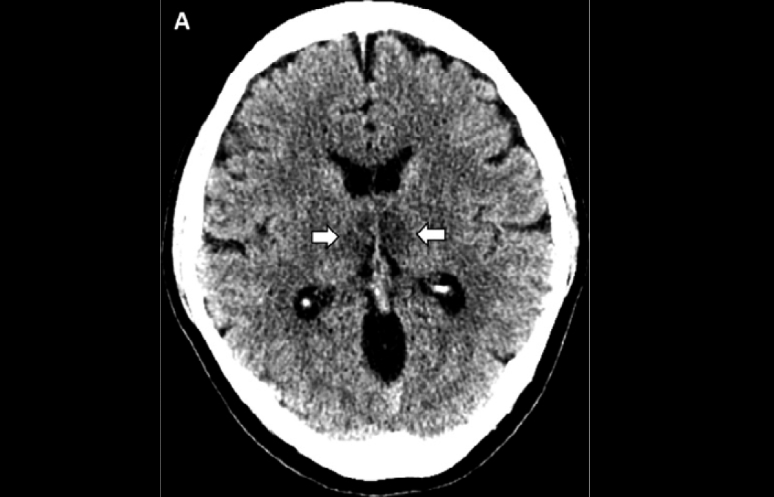Woman with COVID-19 developed a rare brain condition. Doctors suspect a link.
The rare condition has been associated with other viral infections, including influenza and herpes.

—Coronavirus in the US: Map & cases
—What are coronavirus symptoms?
—How deadly is the new coronavirus?
—How long does coronavirus last on surfaces?
—Is there a cure for COVID-19?
—How does coronavirus compare with seasonal flu?
—How does the coronavirus spread?
—Can people spread the coronavirus after they recover?
A woman who tested positive for COVID-19 developed a rare brain disease known as acute necrotizing encephalopathy, a condition that can be triggered by viral infections like influenza and herpes.
At this point, the brain damage "has yet to be demonstrated as a result of COVID-19 infection," according to a case report published March 31 in the journal Radiology. However, as the novel coronavirus continues to spread, "clinicians and radiologists should be watching for this presentation among patients presenting with COVID-19 and altered mental status," the authors wrote.
"We need to be thinking of how we’re going to incorporate patients with severe neurological disease into our treatment paradigm," Dr. Elissa Fory, a Henry Ford neurologist who was part of the team of medical experts involved in making the diagnosis, said in a statement. "This complication is as devastating as severe lung disease."
The woman, a 58-year-old airline worker, checked into the Henry Ford Health System in Detroit, after having a fever, cough (known coronavirus symptoms) and "altered mental status" for three days, the report noted. At the hospital, the woman appeared confused, lethargic and disoriented, the statement noted. She tested negative for influenza, herpes, Varicella zoster virus (which causes chickenpox) and West Nile virus; and her cerebrospinal fluid, which saturates the brain and spinal cord, contained no trace of bacterial infection.
Noting her symptoms, the doctors also tested the patient for COVID-19 using a diagnostic test provided by the U.S. Centers for Disease Control and Prevention (CDC), and found that she tested positive for the disease.
Related: 10 deadly diseases that hopped across species

CT scans of the woman's brain revealed symmetrical tissue damage in the thalamus — a structure buried in the center of the brain that helps relay sensory information from the body to the rest of the organ, according to BrainFacts.org. These damaged areas appeared darker on the woman's CT scan than they did in a scan of a healthy brain, meaning they were less dense than usual, according to an explanation of radiological terms from St. Vincent's University Hospital. Brain regions can become less dense when due to edema, when excess fluid floods the tissue after injury, or necrosis, when cells making up the tissue die off in large quantities, the case study authors noted.
Get the world’s most fascinating discoveries delivered straight to your inbox.
The doctors gathered additional scans of the woman's brain using MRIs (magnetic resonance imaging) and examined them to find evidence that the patient had suffered a hemorrhage, or bleeding from a ruptured blood vessel. They again found damage in the thalamus, as well as in portions of the wrinkled cerebral cortex and in brain regions that lie just below its folds. The doctors diagnosed the woman with acute necrotizing encephalopathy, which, if left untreated, can progress to cause "coma, liver problems and neurological deficits," according to The National Institutes of Health's Genetic and Rare Disease Information Center (GARD).
"The team had suspected encephalitis at the outset, but then back-to-back CT and MRI scans made the diagnosis," Fory said.
The rare condition develops most commonly after a viral infection, such as those caused by influenza A, influenza B and the human herpes virus 6, according to GARD. These infections can trigger a so-called cytokine storm in the brain, when inflammatory substances that normally help the body fight off disease instead go haywire and damage the infected tissue, the case report authors noted. Cytokine storms break down the tissue that surrounds blood vessels in the brain, known as the blood-brain barrier, and can thus lead to hemorrhage, they wrote.
Although the doctors could not directly demonstrate that COVID-19 triggered the woman's unusual brain disease, a recent report in the journal the Lancet suggests that a subset of infected patients appear vulnerable to brain-bound cytokine storms. In addition, a case report published in the Cureus Journal of Medical Science described a 74-year-old patient with both COVID-19 and signs of encephalopathy.
It should be noted that "elderly patients with chronic conditions are at an increased risk of altered mental status in the setting of acute infections," the authors of the Cureus paper wrote. At this point, the potential neurological symptoms of COVID-19 are not well understood, but they should be further investigated in infected patients, they added. Altered mental status might even serve as an early symptom of COVID-19 in some people, they said.
"If patients with neurological conditions are not considered to have COVID-19, this may present a nationwide issue to health care team members treating patients and in turn the general public if they are discharged and further exposed to other people," the Cureus authors noted.
- Going viral: 6 new findings about viruses
- The 12 deadliest viruses on Earth
- Top 10 mysterious diseases
Originally published on Live Science.
OFFER: Save at least 53% with our latest magazine deal!
With impressive cutaway illustrations that show how things function, and mindblowing photography of the world’s most inspiring spectacles, How It Works represents the pinnacle of engaging, factual fun for a mainstream audience keen to keep up with the latest tech and the most impressive phenomena on the planet and beyond. Written and presented in a style that makes even the most complex subjects interesting and easy to understand, How It Works is enjoyed by readers of all ages.

Nicoletta Lanese is the health channel editor at Live Science and was previously a news editor and staff writer at the site. She holds a graduate certificate in science communication from UC Santa Cruz and degrees in neuroscience and dance from the University of Florida. Her work has appeared in The Scientist, Science News, the Mercury News, Mongabay and Stanford Medicine Magazine, among other outlets. Based in NYC, she also remains heavily involved in dance and performs in local choreographers' work.



